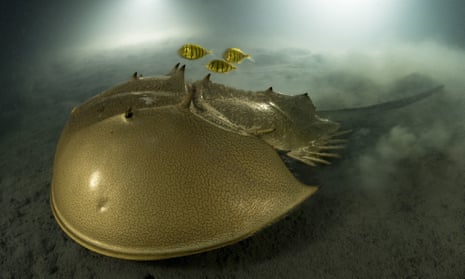They are some of the most spectacular images currently on display at the Wildlife Photographer of the Year exhibition in London. Huge pictures of weird creatures with golden carapaces and multiple legs scuttling across the seabed now adorn the walls of the city’s Natural History Museum.
The award-winning photographs, taken by Laurent Ballesta, could be visions of extraterrestrial lifeforms. In fact, they are horseshoe crabs that evolved hundreds of millions of years ago and which are some of Earth’s oldest species. These living fossils thrive on the ocean floor where they root out worms, algae, and clams that they crush between their legs before eating.
The biological relationship between horseshoe crabs and Homo sapiens is distant. Yet these strange creatures have become a vitally important cog in modern life – for their bright blue blood is a critical component of tests to assess the safety of vaccines, insulin injections and many other medical interventions used by humans today.
“Harvesting horseshoe crabs for their blood has saved millions of lives,” said Rich Gorman of Sussex University, author of a recent study of the horseshoe crab. “If you’ve ever been given a vaccine, you can thank the horseshoe crab for ensuring that your jab was safe.”
But the exploitation of the horseshoe – which is more closely related to spiders than crabs – has come at a price, added Gorman. Biologists say they are now under grim evolutionary pressures that are triggering precipitous declines in their numbers, particularly on the eastern seaboard of America. Hundreds of thousands are having their blood taken, triggering swathes of deaths and reducing populations in key breeding areas such as Delaware Bay in New Jersey.
This decrease has also had wider ecological consequences. Major drops in populations of birds, such as the rufa red knot, are now being reported in the wake of the horseshoe’s decline.
Every spring, thousands of red knots used to fly to Delaware Bay from the tip of South America and gorge themselves on the millions of eggs laid there by crabs during the horseshoe spawning seasons. Then the birds would fly off for the remainder of their 9,000-mile migration to the Arctic. However, recent drastic drops in red knot numbers have been reported, and these have, in turn, been blamed on the decline of the horseshoe crab.
In addition, horseshoes provide fishermen with a key source of bait, and this widespread exploitation has also contributed to the ecological pressures on the horseshoe. As a result, a ban was imposed this year on the harvesting of female horseshoes in Delaware Bay.
But many ecologists believe that there is no longer an excuse for using horseshoes, either for bait or as a source of medical materials. “The fisheries – such as eel fishing – that used horseshoe crabs as bait are dwindling, and there are alternatives to using their blood for medical products,” said Larry Niles, a wildlife biologist in New Jersey. “So there’s no reason to be killing these animals at all.”

This last point is backed by scientists. They say that viable alternatives to toxicity tests using horseshoe blue blood have been on the market for 15 years. These rely on synthetic ingredients and if implemented across the globe could lead to the end of horseshoe bleeding. Only a few organisations – such as Eli Lilly – have chosen to adopt the new synthetic test, mainly because there was no regulatory encouragement for companies to swap techniques.
However, recent changes in the rules set by medical regulators, who set quality and identity standards for medicines, have raised hopes that tests based on horseshoe medicine bleeds could be discouraged and replaced with those that use synthetic ingredients.
European, Japanese, and Chinese pharmacopoeias have passed regulations aimed at securing such a goal, and a similar decision is expected in the US in the near future.
after newsletter promotion
“Changing the rules will certainly help but we will still have to persuade companies that they need to change their practices and save the horseshoe crab,” said Niles. “They won’t do that overnight.”
True blue test
Horseshoe crabs evolved around 450 million years ago, long before the appearance of dinosaurs. There are four species: three from Asia and one that lives along the east coast of North America. The last is the main source of crabs for bleeding.
The blood of horseshoes contains cells that are exceptionally sensitive to toxic bacteria. When those cells meet invading micro-organisms, they form clots and so protect the rest of the horseshoe crab’s body, a phenomenon that scientists exploited to develop the limulus amebocyte lysate (LAL) test in the 1970s. This can determine if medical products, such as vaccines, have been contaminated with dangerous bacteria.
To obtain supplies of the blood needed to make these tests, hundreds of thousands of horseshoe crabs are gathered every year. Their blood is extracted and the animals are then returned to their shoreline homes. One estimate, made in 2021, suggested that of 718,809 horseshoe crabs collected for these bleedings, a total of 112,104 died, around 15%. Other conservation groups put that death toll at around 30% or more, however.
“About half of a crab’s blood is taken from each animal and that is simply too much,” said Larry Niles, a wildlife biologist in New Jersey. “They are being killed in vast numbers, and that is having severe ecological consequences not just for the crabs but for other creatures that eat the eggs that the horseshoe crab lays.”
